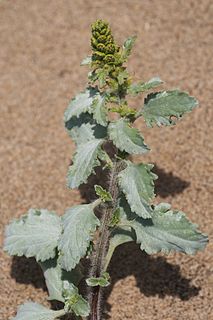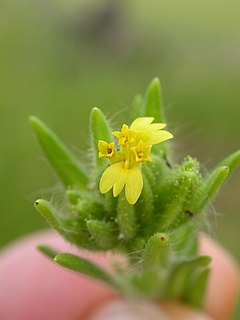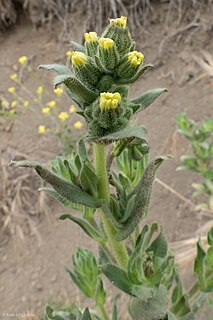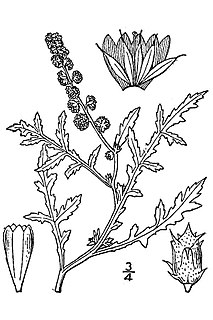
Ragweeds are flowering plants in the genus Ambrosia in the aster family, Asteraceae. They are distributed in the tropical and subtropical regions of the Americas, especially North America, where the origin and center of diversity of the genus are in the southwestern United States and northwestern Mexico. Several species have been introduced to the Old World and some have naturalized and have become invasive species. Ragweed species are expected to continue spreading across Europe in the near future in response to ongoing climate change.

Ambrosia artemisiifolia, with the common names common ragweed, annual ragweed, and low ragweed, is a species of the genus Ambrosia native to regions of the Americas.

Ambrosia dumosa, the burro-weed or white bursage, a North American species of plants in the family Asteraceae. It is a common constituent of the creosote-bush scrub community throughout the Mojave desert of California, Nevada, and Utah and the Sonoran Desert of Arizona and northwestern Mexico.

Ambrosia trifida, the giant ragweed, is a species of flowering plant in the family Asteraceae. It is native to North America, where it is widespread in Canada, the United States, and northern Mexico.

Ambrosia chamissonis is a species of ragweed known by the common names silver burr ragweed, silver beachweed and (silver) beach bur(r).

Ambrosia psilostachya is a species of ragweed known by the common names Cuman ragweed and perennial ragweed, and western ragweed.

Ambrosia chenopodiifolia is a species of ragweed known by the common names San Diego bursage and San Diego bur ragweed. It is native to the Mexican states of Baja California and Baja California Sur, as well as to Orange and San Diego Counties it int US State of California. It is a member of the coastal sage scrub plant community.

Ambrosia confertiflora is a North American species of ragweed known by the common name weakleaf bur ragweed.

Ambrosia eriocentra is a North American species of ragweed known by the common names woolly bursage and woollyfruit burr ragweed.

Symphyotrichum ascendens is a species of flowering plant in the family Asteraceae known by the common names western aster, long-leaved aster, and Rocky Mountain aster. Blooming July–September, it is native to western North America and can be found at elevations of 500–3,200 m (1,600–10,500 ft) in several habitats.

Brickellia grandiflora, known by the common name tasselflower brickellbush, is a species of flowering plant in the family Asteraceae.

Symphyotrichum pilosum, commonly called hairy white oldfield aster or frost aster, is a flowering plant in the family Asteraceae native to central and eastern North America. It is a perennial, herbaceous plant that may reach 20 to 120 centimeters tall. Its flowers have white ray florets and yellow disk florets.

Madia glomerata is a species of flowering plant in the family Asteraceae known by the common name mountain tarweed.

Madia sativa, known by the common names coast tarweed and Chilean tarweed, is a species of flowering plant in the family Asteraceae found in parts of western North and South America.

Ambrosia tomentosa, the skeletonleaf bur ragweed, silverleaf povertyweed, or skeleton-leaf bursage, is a North American species of perennial plants in the family Asteraceae.
Ambrosia linearis is a species of flowering plant in the family Asteraceae known by the common names streaked bur ragweed, Colorado bursage, linear-leaf bursage, and plains ragweed. It is endemic to east-central part of the state of Colorado in the United States, where it occurs in Elbert, Pueblo, El Paso, Cheyenne, Crowley, Kiowa and Lincoln Counties.

Ambrosia salsola, commonly called cheesebush, winged ragweed, burrobush, white burrobrush, and desert pearl, is a species of perennial shrub in the family Asteraceae native to deserts of the southwestern United States and northwestern Mexico.
Ambrosia bidentata, the lanceleaf ragweed, is a North American species of plants in the family Asteraceae. It is native to the central and eastern parts of the United States, primarily the Mississippi Valley and the eastern Great Plains.
Ambrosia cordifolia, called the Tucson bur ragweed, is a North American species of plant in the family Asteraceae. It is native to northern Mexico and the State of Arizona in the United States.
Ambrosia grayi, the woollyleaf bur ragweed, is a North American species of plants in the family Asteraceae. It is native to the west-central part of the Great Plains of the United States, in the states of Nebraska, Kansas, Colorado, New Mexico, Oklahoma, and Texas.
















